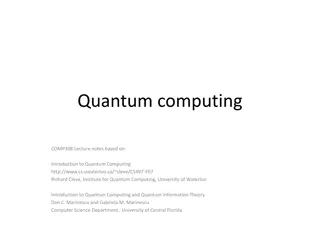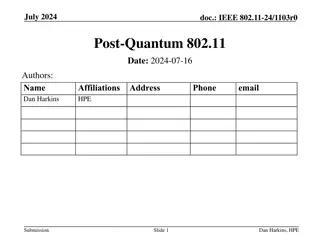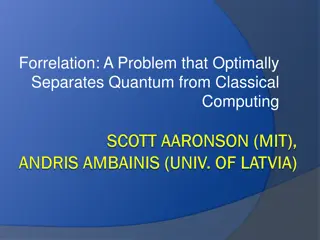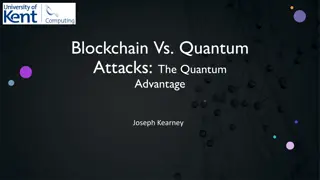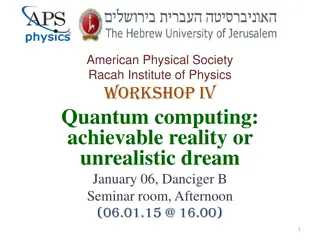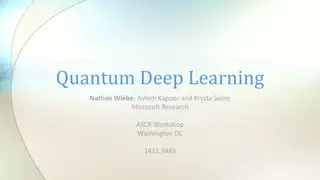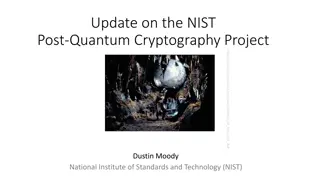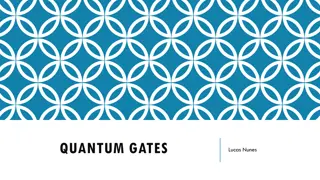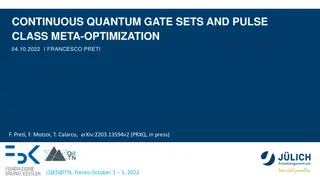Exploring 3D Transmon Qubits in Quantum Computing
This document delves into the initialization, read-out, and measurement techniques of 3D transmon qubits as integral components of quantum computing. It covers the underlying principles of superconducting qubits, SRF cavity utilization, and the roadmap for improving quantum memory and coherence time. Detailed schematics of measurement setups, dispersive shifts, ground state methodologies, and the significance of low powers in quantum operations are presented. The research is based on the work supervised by Dr. Alexander Romanenko and Helen Edwards at ETH Zurich and Yale University. Exciting insights into the practical aspects of quantum computing are highlighted throughout the presentation.
Download Presentation

Please find below an Image/Link to download the presentation.
The content on the website is provided AS IS for your information and personal use only. It may not be sold, licensed, or shared on other websites without obtaining consent from the author. Download presentation by click this link. If you encounter any issues during the download, it is possible that the publisher has removed the file from their server.
E N D
Presentation Transcript
Initialization and Read-out of 3D Transmon qubit San Vinh Dinh Supervisor: Dr. Alexander Romanenko Helen Edwards Internship Final Presentation 29 08 2018
Qubit Building block of Quantum Computing QSIT 16 course, Qudev Group, ETH Zurich 2 8/31/2024 San Vinh Dinh | Measuring 3D Qubit - Helen Edward Internship Final Presentation
Structure of superconducting 3D Transmon Qubit Atomic Physics Perspective Excited energy of valence electrons Different wavefunctions Electrical Engineering Perspective Excited energy of circuit Different impedances (LC circuit) Hyper Physics, Hydrogen atom Schuster thesis, Yale (2007) https://slideplayer.com/slide/7042332/ Why do we need a circuit as an artificial atom ? Why do we need Josephson junction? Schuster thesis, Yale (2007) https://www.ntt-review.jp/archive/ntttechnical.php?contents=ntr200801sp6.html 3 8/31/2024 San Vinh Dinh | Measuring 3D Qubit - Helen Edward Internship Final Presentation
SRF Cavity and Qubit Why do we use SRF cavity with the qubit? Motivation Decoherence Qudev Group, ETH Zurich Reagor thesis, Yale (2015) Schuster thesis, Yale (2015) 4 8/31/2024 San Vinh Dinh | Measuring 3D Qubit - Helen Edward Internship Final Presentation
Roadmap for the project Improving Quantum Memory Decoherence Time Rabi Oscillation TransmonStick Dispersive shift Excited state Qubit Spectroscopy 65 mm Dispersive shift Ground state 5 8/31/2024 San Vinh Dinh | Measuring 3D Qubit - Helen Edward Internship Final Presentation
Schematic of measurement setup Port 6 Port 5 0 dB 0 dB Qubit Oscillator 3.7 GHz -15 dBm -15 dBm 20 dB 0 dB 3 dB isolated combiner Spectrum Analyzer G=40 dB NF=0.06 dB -66.5 dBm G=21 dB NF=1.4 dB G=17 dB NF=2.4 dB 6 dB 0 dB Cavity Oscillator 2.6 GHz -16.5 dBm 6 dB 0 dB Variable attenuator 50 dB 20 dB 0 dB Incident Transm. 2.6 GHz Cavity + transmon 6 8/31/2024 San Vinh Dinh | Measuring 3D Qubit - Helen Edward Internship Final Presentation
Dispersive shift Ground state Method Sweeping frequency and power of input signal around cavity and taking average (4000 measurements) Dispersive shift at low power Photon numbers: around 10^5, ideally 1 Why do we need low powers? Sgen Cavity Drive 2.6 GHz Cavity Spectrum Analyser Sweeping power and frequency 7 8/31/2024 San Vinh Dinh | Measuring 3D Qubit - Helen Edward Internship Final Presentation
Qubit Spectroscopy Looking the frequency and power that the Ground State Dispersive peak disappear Why do we see multiple peaks at varied powers? f01 f02/2 f12 f03/3 SGen Cavity Drive SGen Qubit Drive Qubit energy level Michael thesis, Oxford (2016) Multiphoton absorption From book: Frontiers in Guided Wave Optics and Optoelectronics 2.6 GHz Cavity Spectrum Analyser Sweeping power and frequency 8 8/31/2024 San Vinh Dinh | Measuring 3D Qubit - Helen Edward Internship Final Presentation
Dispersive shift Excited state Reading out Excited State Sweep frequencies of qubit and cavity Expected shift: 140 Hz Actual shift: 50 Hz SGen Cavity Drive SGen Qubit Drive Sweeping frequency Michael thesis, Oxford (2016) 2.6 GHz Cavity Spectrum Analyser Sweeping frequency 9 8/31/2024 San Vinh Dinh | Measuring 3D Qubit - Helen Edward Internship Final Presentation
Rabi Oscillation Bianchetti, Phys. Rev. A 80, 043840 (2009) http://www.wmi.badw.de/teaching/ Lecturenotes/AS/AS2013_Chapter10_2_Slides.pdf QuDev Group, Summer school ETH Zurich 10 8/31/2024 San Vinh Dinh | Measuring 3D Qubit - Helen Edward Internship Final Presentation
Rabi Oscillation SGen Cavity Drive Pulse generation + triggering Expected result Bianchetti, Phys. Rev. A 80, 043840 (2009) 11 8/31/2024 San Vinh Dinh | Measuring 3D Qubit - Helen Edward Internship Final Presentation
Summary Quantum Memory Decoherence Time Rabi Oscillation Dispersive shift Excited state Qubit Spectroscopy Dispersive shift Ground state Thank you for the support of: - Dr. Romanenko and Dr. Martinello Supervisor - Quantum Initiative Group and SRF Group at Technical Division - Helen Edward Internship Committee - Fermilab Administration - Other interns at Fermilab - University of St Andrews 12 8/31/2024 San Vinh Dinh | Measuring 3D Qubit - Helen Edward Internship Final Presentation





